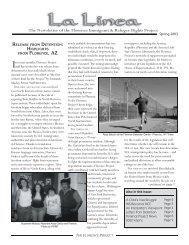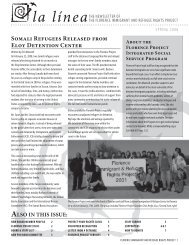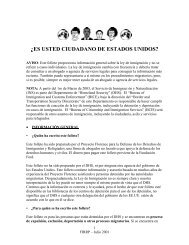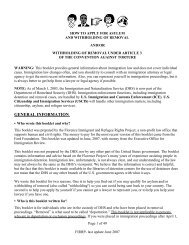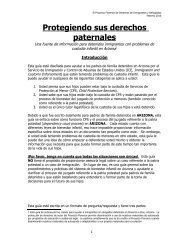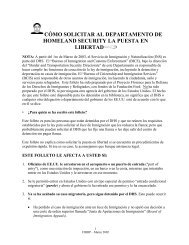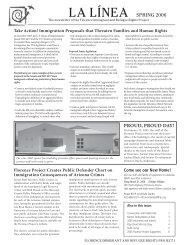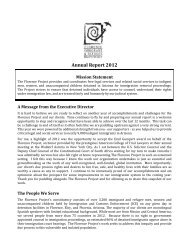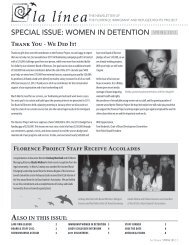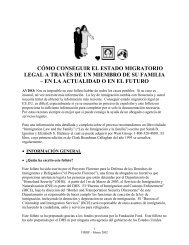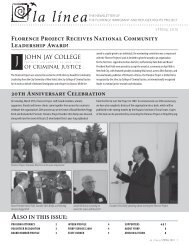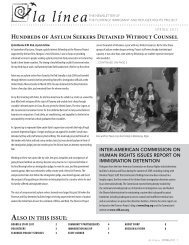quick reference chart and annotations for determining immigration ...
quick reference chart and annotations for determining immigration ...
quick reference chart and annotations for determining immigration ...
You also want an ePaper? Increase the reach of your titles
YUMPU automatically turns print PDFs into web optimized ePapers that Google loves.
Immigrant Legal Resource Center, Florence Immigrant <strong>and</strong> Refugee Rights Project,<br />
Maricopa County Public Defender August 2012<br />
B. Subsection A shall apply in all cases except those which are compromised by leave of court as<br />
provided by law.<br />
C. Compounding is a class 6 felony if the crime compounded is a felony. If the crime compounded is not<br />
a felony, compounding is a class 3 misdemeanor.<br />
Summary: This may be a good alternative to a controlled substance offense, particularly <strong>for</strong><br />
defendants who are involved in a drug trafficking scheme but must avoid a controlled substance<br />
conviction <strong>for</strong> <strong>immigration</strong> purposes. Immigration counsel can also make the argument that it is not a<br />
CMT.<br />
Crime Involving Moral Turpitude (CMT): While this may be held a CMT, <strong>and</strong> at least one<br />
<strong>immigration</strong> judge has done so, <strong>immigration</strong> attorneys have strong arguments against this. The elements<br />
of this offense most closely match the elements of misprision or accessory after the fact, with the added<br />
element of a pecuniary benefit. In Navarro-Lopez v. Gonzales, 503 F.3d 1063 (9th Cir. 2007) (en banc)<br />
(overturned on other grounds), the Ninth Circuit found that a conviction <strong>for</strong> accessory after the fact was<br />
not categorically a crime involving moral turpitude since it could include such conduct as a person<br />
providing food <strong>and</strong> shelter to a family member who has committed a crime. While ICE may argue that<br />
the element of a “pecuniary benefit” turns the offense into a CMT, there is not necessarily any legal<br />
authority <strong>for</strong> this position. There is no required intent to do harm, <strong>and</strong> a person might refrain from<br />
reporting a crime not only <strong>for</strong> the pecuniary gain, but out of desire to help a relative, or fear of reprisal<br />
from the perpetrator.<br />
Aggravated Felony: It should not be, although counsel should attempt to avoid a sentence of<br />
365 or more on any single count because of the danger that the government would assert that this<br />
constitutes obstruction of justice. A conviction relating to obstruction of justice is an aggravated felony if<br />
a sentence of one year or more is imposed. 8 U.S.C. § 1101(a)(43)(S). The BIA held that accessory after<br />
the fact under 18 USC § 3 (hiding <strong>and</strong> giving com<strong>for</strong>t to a person who committed a crime) is obstruction<br />
of justice. Matter of Batista-Hern<strong>and</strong>ez, 21 I&N Dec. 955 (BIA 1997). However, it held that Misprision<br />
of a felony under 18 USC § 4 (concealing that a crime was committed) is not obstruction of justice.<br />
Matter of Espinoza, 22 I&N Dec. 889 (BIA 1999). Compounding requires even less action than federal<br />
misprision, because it can be violated by merely refraining from reporting while misprision requires<br />
active concealment. The addition of pecuniary gain does not make the offense more closely related to<br />
obstruction. However, as always counsel should attempt to secure a sentence of 364 days or less.<br />
55. Tampering with a Public Record, ARS § 13-2407<br />
A. A person commits tampering with a public record if, with the intent to defraud or deceive, such person<br />
knowingly:<br />
1. Makes or completes a written instrument, knowing that it has been falsely made, which purports to be a<br />
public record or true copy thereof or alters or makes a false entry in a written instrument which is a public<br />
record or a true copy of a public record; or<br />
2. Presents or uses a written instrument which is or purports to be a public record or a copy of such public<br />
record, knowing that it has been falsely made, completed or altered or that a false entry has been made,<br />
with intent that it be taken as genuine; or<br />
3. Records, registers or files or offers <strong>for</strong> recordation, registration or filing in a governmental office or<br />
agency a written statement which has been falsely made, completed or altered or in which a false entry<br />
has been made or which contains a false statement or false in<strong>for</strong>mation; or<br />
4. Destroys, mutilates, conceals, removes or otherwise impairs the availability of any public record; or<br />
Arizona Criminal Chart with Explanatory Endnote – August 2012<br />
68



